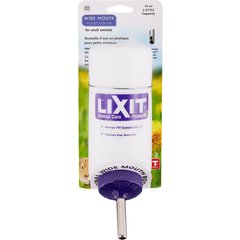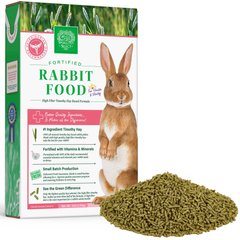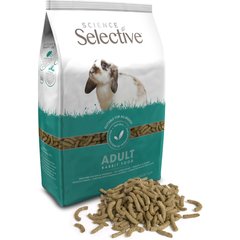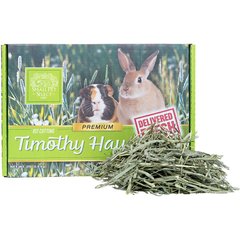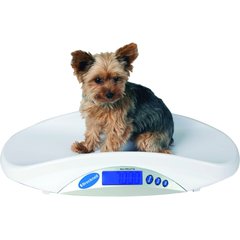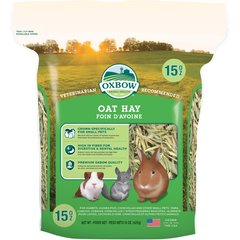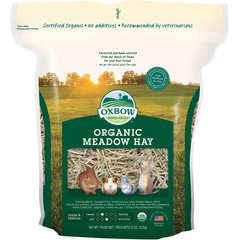Obesity in Rabbits: Causes and How To Help Your Rabbit
kaew6566/iStock / Getty Images Plus via Getty Images
Obesity in rabbits occurs when there is an accumulation of excess body fat due to an imbalance between caloric intake and expenditure of those calories through exercise and daily activity.
Key Takeaways
- Obese rabbits typically exhibit physical signs such as larger bellies, fat folds under the chin (known as a dewlap), and fat deposits around the armpits.
- Obesity in rabbits causes chronic low-grade inflammation, predisposing pets to a range of medical issues.
- Certain factors can increase a rabbit’s predisposition to obesity. Dwarf breeds, which are naturally stockier, and larger breeds, like Flemish Giants, are more prone to weight gain.
What Is Obesity in Rabbits?
Obesity in rabbits often results from factors like an improper diet, insufficient exercise, or underlying medical conditions.
Obese rabbits typically exhibit physical signs such as larger bellies, fat folds under the chin (known as a dewlap), and fat deposits around the armpits.
Excess calories are converted into fat and stored throughout the body, including around internal organs and in the subcutaneous layers just beneath the skin.
This excessive fat accumulation can lead to various health problems.
For example, obese rabbits may struggle with grooming, making it difficult to clean their hindquarters, which can result in soiled fur from urine or feces.
Skin folds created by excess fat can harbor bacteria or yeast, leading to skin irritation and inflammation.
Additionally, obesity in rabbits causes chronic low-grade inflammation, predisposing them to a range of medical issues, such as arthritis, gastrointestinal stasis, pododermatitis, cancer, liver disease, heart disease, and urinary sludge (when crystals settle in the bladder) that can then mineralize and form stones and cause infections.
While obesity itself develops over time, and is rarely an immediate medical emergency, certain symptoms—such as difficulty breathing, refusal to eat, or abnormal stool production—warrant urgent veterinary attention.
Symptoms of Obesity in Rabbits
Symptoms of obesity in rabbits may include:
-
Lethargy or decreased activity
-
Excess fat around belly, armpits, under chin, and in between back legs
-
Skin fold irritation/dermatitis
-
Fecal or urinary soiling of fur
-
Pododermatitis (foot inflammation)
-
Gastrointestinal stasis
-
Unkempt fur
-
Difficulty hopping and moving around
Causes of Obesity in Rabbits
Obesity in rabbits is commonly caused by an improper diet, insufficient exercise, or underlying medical conditions.
Diets high in calorie-dense foods, such as carbohydrate-rich pellets, excessive treats, or sugary fruits like apples and carrots, can lead to unhealthy weight gain.
Rabbits that spend most of their time confined to enclosures without adequate daily exercise—such as running or hopping—are also at risk of becoming overweight.
Additionally, rabbits with limited mobility due to disabilities, arthritis, or other medical conditions require careful dietary management to prevent obesity and avoid exacerbating their health issues.
Certain factors can increase a rabbit’s predisposition to obesity. For example, dwarf breeds, which are naturally stockier, and larger breeds, like Flemish Giants, are more prone to weight gain.
Middle-aged rabbits (4–5 years old) are also at higher risk due to their slowing metabolism. Hormonal changes after spaying or neutering can further increase the likelihood of weight gain, making regular dietary monitoring essential for these rabbits.
How Veterinarians Diagnose Obesity in Rabbits
Veterinarians diagnose obesity in rabbits by evaluating body weight, body condition, and overall health.
While a standardized body condition scoring system for rabbits has not yet been universally validated due to their unique body compositions, it can still serve as a useful subjective guide.
During a physical exam, your veterinarian will visually assess your rabbit and palpate key areas, such as the ribs, spine, and pelvis, to determine how easily these structures can be felt.
They will also examine the size of the dewlap, assess waist visibility, and evaluate the ease of palpating internal organs. These observations help your vet determine whether your rabbit’s body condition aligns with their ideal weight.
If necessary, additional diagnostic tests may be performed to identify underlying conditions contributing to weight gain or assess complications from obesity:
-
Complete Blood Count (CBC): Evaluates white blood cells, red blood cells, and platelets to check for signs of infection, anemia, or dehydration.
-
Chemistry Panel: Measures electrolytes, enzymes, and organ function, which is important for detecting issues such as hepatic lipidosis, a condition that can occur if an obese rabbit stops eating.
-
X-rays (Radiographs): Provides imaging to assess joints for arthritis, evaluate gastrointestinal motility, and rule out abdominal enlargement caused by organ disease.
Do not fast your rabbit before these tests. Unlike humans, rabbits must continue eating and drinking to maintain their gastrointestinal health.
Ensure your rabbit has access to hay in their carrier and consider providing a small water bottle to keep them hydrated.
Additionally, inform your veterinarian about any abnormalities you’ve observed at home, such as diarrhea, urinary changes, or respiratory issues.
This information helps guide the selection of the most appropriate tests for your rabbit’s condition.
Treatment of Obesity in Rabbits
Treating obesity in rabbits focuses on dietary adjustments and increased exercise.
After discussing your rabbit’s current diet and environment with your veterinarian, they will create a tailored weight loss plan.
Dietary changes typically involve gradually phasing out cereal mixes and reducing high-calorie pellet portions over several weeks.
Low-calorie or light pellets can be introduced as healthier alternatives. A diet rich in indigestible fiber, primarily from hay, is essential for weight loss and maintaining healthy digestion.
Ensure your rabbit has unlimited access to hay, particularly low-calorie, high-fiber options like first-cut hay.
Vegetables can still be offered in small amounts as treats but should be carefully portioned.
Exercise is another critical component. Encourage daily activity using toys, tunnels, and safe spaces for hopping and exploring.
Puzzles and interactive setups can also stimulate mental and physical activity.
It's important to make these changes gradually over several weeks to avoid gastrointestinal upset or anorexia.
Weight loss in rabbits often takes weeks to months, and maintaining a consistent diet and exercise routine is crucial to prevent the weight from returning.
Medications are not typically needed to treat obesity unless your rabbit has other underlying medical conditions that need treatment.
If your rabbit stops eating at any point, provide them supplement feedings with a feeding formula and get them seen immediately.
Recovery and Management of Obesity in Rabbits
Once your rabbit reaches their ideal weight, make sure to maintain their new dietary and exercise routines to prevent weight regain.
Returning to an old diet or providing excessive treats can quickly reverse progress, leading to unhealthy weight gain.
To monitor your rabbit’s weight, consider weighing them weekly using a reliable scale.
This helps ensure they are maintaining a healthy weight without continued weight loss or regaining excess weight. Keep a record of their weight trends to track progress over time.
Regular check-ins with your veterinarian are highly beneficial during the recovery process.
These visits provide an opportunity to assess your rabbit’s overall health, confirm they are maintaining their ideal weight, and make any necessary adjustments to their diet or exercise plan.
Staying proactive about your rabbit’s weight and health will help ensure long-term success.
Prevention of Obesity in Rabbits
Preventing obesity in rabbits begins with proper diet and regular exercise. High-quality hay—such as timothy, oat, meadow, or orchard hay—is essential for adult rabbits as it is high in fiber and low in calories.
You can offer pellets, but avoid muesli or cereal mixes.
Limit pellet portions to approximately 1/4 to 1/2 cup per 4–5 pounds of body weight daily.
Fresh leafy vegetables should be offered daily, in portions roughly the size of your rabbit’s head. Treats and fruits should be limited to occasional snacks, no more than once a week.
In addition to a healthy diet, regular exercise is vital. Provide your rabbit with a large, safe area to hop and explore daily. Offering tunnels, toys, and puzzles can also encourage physical activity and mental stimulation.
Regular veterinary checkups, ideally annually or biannually, are important for detecting any underlying conditions that could contribute to weight gain.
Early intervention can help prevent obesity before it becomes a problem.
Obesity in Rabbits FAQs
How do you treat obesity in rabbits?
Obesity in rabbits is treated through a combination of dietary changes and increased exercise, under the guidance of a primary veterinarian.
What is the obesity scale for rabbits?
Rabbits have a body condition scale, typically ranging from 1 to 5, but it is not universally validated, so it should only serve as a general guide due to their unique body composition.
Why is my bunny getting so fat?
Weight gain in rabbits can result from excessive calories, insufficient exercise, or underlying medical conditions, so it's important to consult your veterinarian for a thorough evaluation.
What happens to obese rabbits?
Obese rabbits face an increased risk of joint disease, liver disease, heart disease, urinary issues, and other health problems due to the low-grade inflammation caused by excess body fat.

